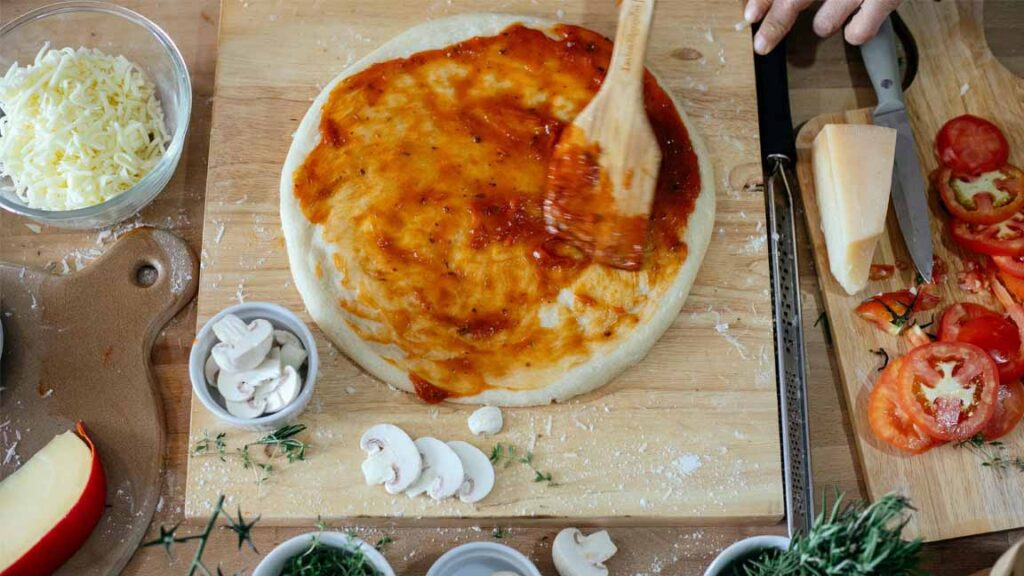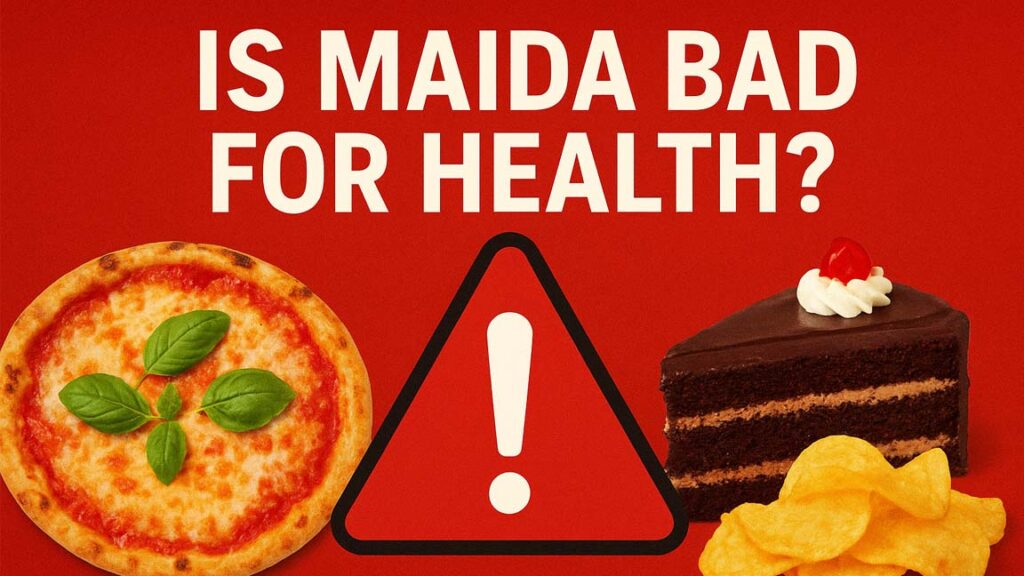Everyday life runs on white-flour comfort—morning toast, tea-time biscuits, roadside samosas, soft pizzas, melt-in-the-mouth cakes, and a hundred snack packs that promise “light and tasty.” Soft? Absolutely. Tempting? Always. But let’s pause for a second and ask the real question: is maida bad for health?
Short answer: it depends on how often it shows up on your plate. The fuller truth sits in two places—how maida is made and what it does once it enters your body. Maida isn’t just “white flour”; it’s wheat that’s been heavily processed [refined] so the fiber and many natural nutrients are stripped away. That’s why people call it “empty calories.” But the story doesn’t end there.
Inside your body, maida behaves a lot like quick fuel—burns fast, spikes energy, and then leaves you tired and hungry again. Over time, that roller-coaster can stress your blood sugar, nudge your weight upward, and bother your digestion. None of this is meant to scare you—it’s meant to give you clarity.
So here’s what we’ll do next: we’ll break down how wheat turns into maida, why that matters, how it affects your blood sugar, gut, heart, and weight, and the simple swaps you can make without feeling deprived. Clear, practical, science-backed—so you can choose better, not just eat less.
Is Maida Bad for Health? The Science-Based Answer
If we strip away the confusion and answer directly: yes, maida is bad for health — especially when it sneaks into your meals every single day.
Think about what maida really is. At its core, it’s just wheat that has been aggressively refined. During that process, the most valuable parts — the fiber, vitamins, and minerals — are polished away. What’s left behind is a super-soft, fine white powder that may look appealing, but inside your body, it behaves more like sugar than wholesome food.
That’s why nutritionists often call it a form of “empty calories.” Your stomach fills up, but your cells don’t get the nutrients they actually need.
👩⚕️ Doctors and researchers consistently point out the same problems:
- Blood sugar spikes → Maida digests so fast that it floods your bloodstream with glucose.
- Fat storage increases → Those sugar surges push your body to store more fat, especially around the belly.
- Digestive troubles → Without fiber, your gut struggles to process it, leading to bloating or constipation.
- Serious health risks → Regular intake raises the chances of type-2 diabetes, obesity, and heart disease.
Now, here’s the balance: eating maida once in a while — a slice of cake at a birthday, or the occasional samosa at a party — isn’t going to destroy your health. The danger lies in daily dependence. If your breakfast, snacks, and dinner sides all contain maida, the risks stack up silently over time.
So, when you ask, “is maida bad for health?” — the science-based answer is clear: yes, if it’s a routine part of your diet. The good news? The moment you start reducing it, your body begins to respond positively.
How Maida Is Made: From Wheat to White Powder
To understand why maida is bad for health, we first need to look at how it’s made. The process sounds simple on paper, but in reality, it strips away the very things that make wheat healthy.
1. The Refining Process
Whole wheat grain has three main parts:
- Bran → the outer layer packed with fiber.
- Germ → the nutrient-rich core with vitamins, minerals, and healthy fats.
- Endosperm → the starchy part that provides energy.
When maida is produced, the bran and germ are deliberately removed. What remains is just the endosperm, finely ground into a soft, white flour. It looks pure and smooth, but nutritionally, it’s hollow.
2. Chemical Bleaching
To make the flour even whiter and give it that “perfect” bakery texture, companies often use bleaching agents like benzoyl peroxide or chlorine dioxide. These chemicals don’t add any nutritional value; they simply make the flour look more attractive on store shelves.
3. The End Result
After all this processing, what’s left is a powder that:
- Has almost no fiber (so digestion slows down).
- Contains minimal protein (so you feel less satisfied).
- Offers very little nutrition (compared to whole wheat).
👉 In short, the refining process takes a wholesome grain and transforms it into a nutritionally poor ingredient that fills your stomach but fails to fuel your body.
Nutritional Profile of Maida: Empty Calories Explained
If you ever flip over a packet of maida and check the nutrition label, one thing becomes very clear: it’s almost all carbohydrates and very little of anything else.
Let’s break it down:
- Carbohydrates: About 75–80% of maida is pure starch. That means quick energy, but also quick crashes.
- Protein: Barely 8–10%, and even that isn’t the kind of protein your muscles can fully rely on.
- Fat: Almost negligible, so it doesn’t keep you full for long.
- Fiber: Practically zero, which is why it doesn’t support digestion.
- Vitamins & Minerals: During refining, most of the natural B vitamins, iron, and magnesium are stripped away.
Now, compare this with whole wheat flour:
- Higher in protein that actually supports muscle repair.
- Naturally rich in fiber, which keeps your gut healthy and appetite balanced.
- Packed with B vitamins, iron, zinc, and magnesium — nutrients your body needs daily.
And here’s the key difference:
👉 Maida gives you calories, not nutrition. You feel full for a short while, but your body is left craving real nourishment. That’s why health experts call it “empty calories” — food that fills the stomach but doesn’t fuel the body.
How Maida Affects Blood Sugar and Diabetes Risk
When people ask, “is maida bad for health?” the first red flag most doctors raise is its effect on blood sugar.
1. High Glycemic Index (GI)
Maida has a high glycemic index, which means foods made from it break down super quickly into glucose. Instead of releasing energy slowly, like whole grains do, maida hits your bloodstream like a sugar rush.
2. The Sugar Spike–Crash Cycle
That quick rush gives you a temporary boost — you feel energetic for a short while. But soon after, your blood sugar crashes, leaving you tired, irritable, and craving more food. It’s like riding a roller coaster your body never asked for.
3. Long-Term Damage
These frequent spikes and crashes put extra pressure on your insulin response. Over time, your body may stop responding properly to insulin, leading to insulin resistance — a major step toward type-2 diabetes.
👉 Real-life example: Eating two maida-based parathas can raise your blood sugar almost as quickly as drinking a glass of sugary cola. The form looks different, but inside your body, the impact is strikingly similar.
4. What Research Says
Multiple studies have shown that people who eat refined grains (like maida) daily are far more likely to develop insulin resistance and diabetes compared to those who eat whole grains such as wheat, oats, or millets.
In short, maida may taste harmless, but for your blood sugar, it’s like adding fuel to fire.
Digestive Issues Linked to Maida Consumption 🩺
One of the biggest reasons nutritionists call maida “unhealthy” is its lack of fiber. Fiber is like a broom for your digestive system — it keeps things moving smoothly. Without it, the whole system slows down.
1. Constipation
Because maida has almost zero fiber, foods made from it (like white bread, pizza base, or biscuits) don’t help your intestines push waste along. Over time, this can cause constipation, making you feel heavy, uncomfortable, and even irritable.
2. Bloating & Acidity
Maida-based foods tend to sit in your stomach longer. That’s why after eating things like noodles, samosas, or pastries, many people feel bloating, heaviness, or acidity. Your stomach is basically struggling to break it down.
3. Gut Health Damage
Your gut is home to trillions of “good bacteria” that thrive on fiber. Since maida starves them of what they need, the balance of gut bacteria begins to shift. This imbalance can weaken digestion and even affect immunity.
4. Chronic Problems
Regular dependence on maida doesn’t just slow digestion — it may also contribute to chronic gut issues like Irritable Bowel Syndrome (IBS), acidity disorders, or inflammatory conditions in the long run.
👉 Simply put, maida doesn’t support your digestive system — it stresses it.
Weight Gain, Obesity, and Metabolic Syndrome ⚠️
Have you ever noticed how after eating a plate of noodles, a burger, or even a couple of biscuits, you feel full for a short time — but soon after, you’re hungry again? That’s the hidden trap of maida.
1. Quick Digestion
Because maida is refined and fiberless, your body digests it very quickly. Instead of giving you long-lasting energy, it burns up fast, leaving you searching for your next snack.
2. The Overeating Trigger
That fast digestion leads to frequent hunger pangs. And what happens when you’re hungry again in an hour? You reach for more food. This cycle easily pushes you into overeating without even realizing it.
3. Fat Storage Machine
Those repeated blood sugar spikes (from maida) force your body to release more insulin. Extra insulin signals your body to store fat — especially around the belly. Over time, this leads to stubborn weight gain that’s hard to shake off.
4. The Bigger Picture: Metabolic Syndrome
If maida-based foods are a regular part of your diet, the risks grow bigger than just extra weight. Doctors often warn about metabolic syndrome, which is a dangerous combination of:
- High blood pressure
- High blood sugar
- Excess belly fat
- Abnormal cholesterol levels
This cluster of problems greatly increases the risk of heart disease, stroke, and diabetes.
👉 Is Maida Bad for Health? In short, maida doesn’t just make you hungrier — it slowly sets the stage for obesity and lifestyle-related diseases.

❤️ Maida and Heart Health: Hidden Cardiovascular Risks
When we think about heart problems, most of us imagine oily food or too much fried stuff. But here’s something surprising: maida can hurt your heart too — and not in small ways.
1. Triglycerides & LDL Cholesterol
Regular intake of maida-heavy foods (like white bread, cakes, or fast food) can raise the levels of triglycerides and “bad” LDL cholesterol in the blood. Both of these are linked directly to clogged arteries.
2. Inflammation in Arteries
Refined carbs like maida cause sudden sugar spikes. These spikes create tiny injuries inside your blood vessels. Over time, this leads to inflammation in the artery walls, making them less flexible and more prone to blockages.
3. Higher Risk of Heart Attack & Stroke
When cholesterol build-up and inflammation combine, the risk of heart attack or stroke naturally rises. What starts as a harmless habit of snacking on biscuits or pastries can silently push your heart toward long-term trouble.
4. What Science Says
Large-scale studies consistently show that people who replace refined grains with whole grains enjoy far better heart health. In fact, some reports suggest that this simple swap can lower the risk of heart disease by 15–20%.
👉 In short, maida doesn’t just challenge your waistline — it can quietly put your heart at risk.
Is Maida Bad for Kids’ Health? Special Concerns 👶
When it comes to children, the impact of maida is even more serious. Kids are in their growth years, and every bite they eat directly shapes their physical and mental development. Unfortunately, maida-based foods like pizzas, burgers, pastries, noodles, and biscuits have become everyday cravings for many children. But here’s why parents should be cautious:
1. Growth & Nutrition Gaps
Maida is stripped of protein, fiber, vitamins, and minerals. For a child, these are essential building blocks for height, strength, immunity, and brain development. If maida-based foods dominate their diet, their bodies may not get the nutrition they need for proper growth.
2. Sugar Spikes & Hyperactivity
Foods made with maida break down into sugar very quickly. This causes a burst of energy, often making kids hyperactive for a short time. But soon after, the sugar crash leaves them feeling tired, cranky, and unable to concentrate. This roller-coaster effect can impact their focus in school and overall mood.
3. Childhood Obesity
One of the fastest-growing health concerns today is childhood obesity. Maida-heavy junk foods are a major culprit because they:
- Digest too quickly → kids feel hungry again soon.
- Encourage overeating → leading to extra calories every day.
- Promote fat storage → especially around the belly.
This not only affects appearance but also raises the risk of early diabetes, weak stamina, and heart issues later in life.
4. Why Parents Must Be Careful
Occasional treats are fine — no parent wants to completely ban birthday cakes or pizza parties. But when maida becomes a daily habit, it can silently affect your child’s growth, weight, and energy levels. That’s why nutritionists strongly advise limiting maida and encouraging whole grains, fruits, veggies, and nuts instead.
👉 In short, kids need nutrients, not empty calories. Replacing maida-based snacks with healthier options is one of the best long-term gifts parents can give to their children.
Myths vs Facts: Is Maida Always Harmful?
When it comes to maida, there’s a lot of confusion. Many people eat it daily without thinking twice, while others try to avoid it completely. The truth lies somewhere in between. Let’s bust some of the most common myths:
🌀 Myth 1: “A little bit of maida won’t harm.”
✅ Fact: This is partly true. If you eat maida occasionally — like a slice of cake on a birthday or samosa at a festival — your body can handle it. The real problem begins when maida becomes a daily habit. Regular intake leads to blood sugar spikes, weight gain, and long-term health risks.
🌾 Myth 2: “Maida is just like wheat.”
✅ Fact: This is completely false. While both come from wheat, the difference lies in processing. Whole wheat flour contains fiber, vitamins, minerals, and protein, while maida is just the starchy part. Imagine eating rice without its husk, bran, or nutrients — that’s exactly what maida is.
🍞 Myth 3: “Brown bread is healthy.”
✅ Fact: Not always. Many so-called “brown breads” in supermarkets are nothing but maida mixed with caramel color or a small portion of wheat flour. Unless the label clearly says 100% whole wheat, chances are you’re eating maida disguised as healthy bread. Always check the ingredients list before trusting the color.
👉 Maida itself isn’t poison, but it is nutritionally poor. The harm comes from frequency and hidden presence in foods we eat every day — biscuits, breads, pizzas, noodles, and even “health snacks.”
Healthy Alternatives to Maida in Daily Diet 🥗
The good news? You don’t have to give up your favorite foods just because maida is harmful. With a few smart swaps, you can enjoy tasty meals while actually nourishing your body. Here are some healthier flours you can bring into your kitchen:
🌾 Whole Wheat Flour
The simplest and most common alternative. Whole wheat flour still contains bran and germ, which means more fiber, protein, and vitamins. Perfect for chapatis, parathas, puris, or even bread. If you’re used to maida’s soft texture, try mixing half wheat + half maida for a transition before switching fully.
🟤 Ragi (Finger Millet)
Ragi is a super grain loaded with calcium, iron, and amino acids. It’s especially good for kids and women. You can make ragi dosas, ragi laddoos, or porridge. Many health-conscious families in India are already swapping evening snacks with ragi-based recipes.
🌽 Jowar & Bajra
Both are naturally gluten-free and packed with fiber, antioxidants, and minerals. They keep you full for longer, making them excellent for weight management. Try making bhakri, rotla, or even jowar pancakes. In rural India, these millets have been staple foods for centuries — and science now proves why.
🥣 Oats
Oats are rich in beta-glucan fiber, which helps lower cholesterol and control blood sugar. Beyond breakfast porridge, you can use oats in idlis, cheelas, or even oat flour cookies as a replacement for maida in baking.
🌼 Besan (Gram Flour)
Besan is high in protein and iron. It’s versatile — think chillas, pakoras, dhokla, or besan ladoos. Unlike maida, besan keeps your energy levels steady instead of giving sugar crashes.
👉 The best part? These alternatives don’t just replace maida — they add real nutrition, satiety, and variety to your meals. Your body feels the difference within weeks when you make the switch.
How to Reduce Maida Intake Without Feeling Deprived
Let’s be honest — giving up maida completely is tough. Most of our favorite foods, from samosas to pastries, are made with it. But here’s the good news: you don’t need to quit overnight. With small, smart changes, you can reduce maida intake without feeling deprived.
1. Read Labels Carefully
Marketers can be tricky. Many “brown breads” or “multigrain biscuits” are still loaded with refined flour + a tiny sprinkle of whole grains. Always check the first ingredient — if it says “refined wheat flour” or “maida,” you know what’s inside.
2. Cook at Home (with Healthy Twists)
Homemade doesn’t have to mean boring. Use whole-grain flours to make pizzas, pancakes, or cakes. For example:
- Whole wheat pizza base tastes just as good once topped with veggies & cheese.
- Oat flour can make soft pancakes for breakfast.
Cooking at home gives you full control over ingredients and avoids hidden maida.
3. Smart Snacking Swaps
Instead of reaching for biscuits or cookies, keep nuts, fruits, roasted chickpeas, or makhana at home and office. They’re crunchy, tasty, and far healthier. Over time, your taste buds will start preferring natural snacks over processed ones.
4. Switch Gradually, Not Abruptly
If you love soft maida chapatis or breads, start by mixing 50% whole wheat + 50% maida. Slowly reduce maida to 25%, then to zero. This way, your taste adjusts naturally without feeling like you’re “missing out.”
👉 Remember, it’s not about being perfect — it’s about making better choices more often. Even reducing 50% of your maida intake can drastically improve your health over time.
Case Study: Countries Warning Against Maida Consumption
When it comes to maida, it’s not just doctors or nutritionists raising concerns — even governments and international health bodies are stepping in. That shows how serious the issue is.
🇮🇳 India
In India, the FSSAI (Food Safety and Standards Authority of India) has been urging people to cut down on refined flour. With the rise of obesity and diabetes, some experts even proposed that junk food packets should carry cigarette-style health warnings. Imagine a samosa packet saying “Excess maida may harm your health” — sounds extreme, but that’s the level of concern.
🇺🇸 United States & 🇪🇺 Europe
In both the US and Europe, dietary guidelines clearly recommend whole grains over refined grains. Supermarkets there now highlight “100% whole wheat” or “whole grain certified” labels because people are becoming aware. In fact, many schools have replaced white-bread sandwiches with whole-grain bread as part of children’s lunch programs.
🌐 World Health Organization (WHO)
The WHO has repeatedly warned against overconsumption of refined carbohydrates like maida. Their recommendation is simple: choose whole grains whenever possible, and minimize refined flour. Why? Because refined carbs contribute to the global surge in obesity, diabetes, and heart disease.
👉 The big picture is clear: from India to the US to the WHO, everyone is pointing to the same truth — maida is a public health concern. If entire countries are changing their food policies, it’s definitely a sign for us as individuals to rethink our choices too.

FAQ: Common Questions About Maida and Health ❓
1. Is maida bad for health in small amounts?
Not really — your body can handle an occasional pastry or samosa. The real problem begins when maida becomes part of your daily diet. Think of it like sugar — once in a while it’s fine, but daily intake quietly harms your health.
2. Why is maida called empty calories?
Because it gives you energy without giving you nutrition. Maida is stripped of vitamins, minerals, and fiber. You may feel full for a short time, but your body doesn’t get the nutrients it actually needs. It’s like filling petrol in your car without engine oil — it runs, but the damage builds up.
3. Can maida cause diabetes?
Yes, regular consumption of maida-based foods spikes your blood sugar. Over time, this weakens your insulin response, which is the root cause of type 2 diabetes. That’s why doctors often ask diabetic patients to cut out refined flour completely.
4. Is maida safe for kids?
No, not in daily meals. Kids need protein, iron, and vitamins for proper growth, and maida has none of these. Instead, it gives sugar spikes that make kids hyperactive for a while and tired soon after. Frequent intake also raises the risk of childhood obesity.
5. Is bread made from maida harmful?
Yes. White bread is mostly maida, which means high glycemic index and very little nutrition. If bread is a regular part of your diet, switch to 100% whole wheat bread (but check the labels — many “brown breads” are just colored maida).
6. What happens if we stop eating maida?
Within weeks, most people notice:
- Better digestion (less bloating, constipation)
- Steadier energy (no sugar crashes)
- Weight balance (less belly fat)
Long-term, the risk of diabetes, heart disease, and obesity also drops significantly.
7. Which flour is healthier than maida?
- Whole wheat → balanced fiber + protein
- Ragi → high in calcium and iron
- Oats → great for breakfast and heart health
- Jowar & Bajra → gluten-free and fiber-rich
These flours not only give energy but also nourish your body.
8. Is maida bad for digestion?
Yes. Since it has no fiber, maida makes your digestive system sluggish. Over time, it can lead to constipation, acidity, and even chronic issues like Irritable Bowel Syndrome (IBS). Your gut bacteria also starve without fiber, which further worsens digestion.
9. Can maida cause weight gain?
Definitely. Maida digests very fast, making you hungry again soon. This constant hunger → overeating → fat storage (especially belly fat). That’s why maida-based junk foods are strongly linked to obesity and metabolic syndrome.
10. Is it okay to eat maida once in a while?
Yes 👍 Enjoying a slice of cake at a birthday party or a samosa on a rainy day won’t harm you. Just make sure it’s occasional, not habitual. Balance it out with whole grains and healthy foods in your regular meals.
11. Is maida bad for health?
Yes — maida is bad for health when eaten regularly. Since it has almost no fiber, vitamins, or minerals, it only gives you empty calories. Regular consumption leads to sugar spikes, digestive issues, weight gain, and higher risk of diabetes and heart disease. Occasional intake is fine, but daily dependence is harmful.
📝 Final Thoughts: Why You Should Think Twice Before Eating Maida
So, is maida bad for health? The evidence leaves no room for doubt. From blood sugar spikes to poor digestion, from obesity to long-term risks like diabetes and heart disease — maida quietly damages your health when eaten regularly.
The real danger is that it feels harmless. A biscuit with tea, a slice of bread in the morning, or a quick samosa in the evening — each seems small, but together they add up to a daily habit that weakens your body over time.
The good news? You don’t have to “quit life’s pleasures” to stay healthy. By switching to whole grains like wheat, oats, ragi, or jowar, you can still enjoy tasty meals while giving your body the nutrition it deserves. Even reducing maida step by step can make a visible difference in your energy, digestion, and overall health.
👉 The next time you reach for a maida-based snack, pause for a second and ask yourself: Is this choice nourishing me, or just filling me?
Your health — today and in the future — depends on that answer.
🚀 Stay Informed & Make Smarter Health Choices
✨ Dive into these powerful health reads on E-Vichar and take charge of your wellness:
- 🍬 Sugar: The Daily Poison Hiding in Your Food
👉 Know how hidden sugar silently harms your health and how to cut it down smartly. - ⚖️ Obesity: The Hidden Danger to Your Health
👉 Learn how obesity impacts your body beyond weight — and what you can do to reverse it. - 📲 Follow E-Vichar on Facebook
👉 Stay updated with the latest health insights, tips & stories.




